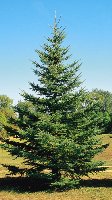Mon-Fri 9am - 5pm Mountain time
Black Hills Spruce vs Wayfaring Tree
Picea glauca var. densata
Viburnum lantana
CUSTOM GROW
Black Hills Spruce is a subspecies of White Spruce native to the Black Hills of South Dakota. It has a strongly conical form, slower growth rate and denser foliage than typical white spruce, making it preferable as a specimen tree for smaller suburban lawns. It also responds well to pruning, and can be used as a hedge or even bonsai.
Wayfaring Tree is an adaptable and reliable shrub. It is prized for its ornamental berries that can range in color from red to yellow to black. Consider getting two trees as fruiting is maximized when another Wayfaring Tree is present.
This species has a variety of uses ranging from naturalization, mass planting, borders, and privacy screens.
Black Hills Spruce Quick Facts
Wayfaring Tree Quick Facts
In row spacing: 3 - 4 m (10 - 12 ft)

